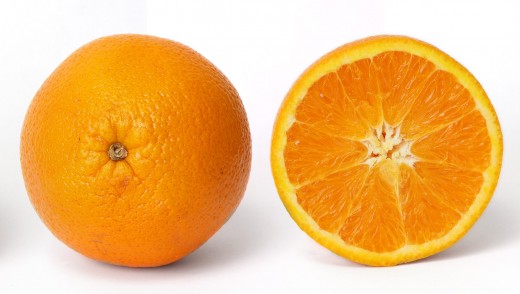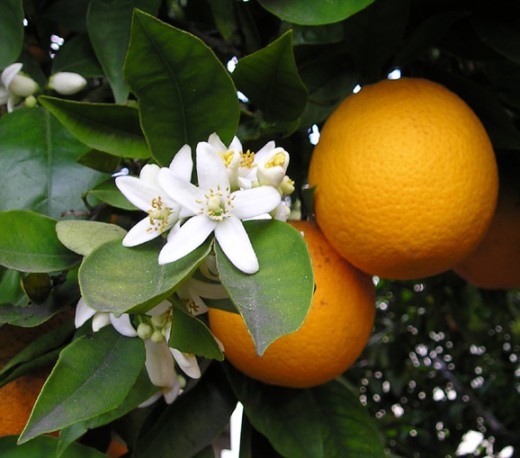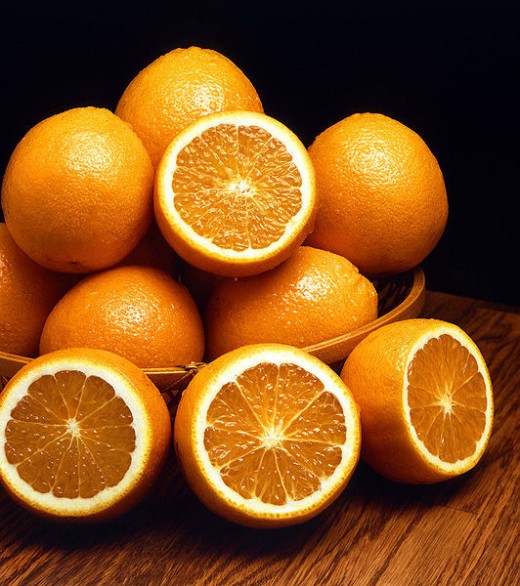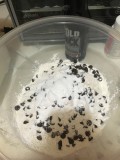What are the Benefits of Orange
Where Did the Orange Originate
The orange began in Southeast Asia (northern India) and the word "orange" is from Sanskrit word naranga. It is not known how long this plant has been used and consumed by humans though it is very likely to have been domesticated for thousands of years.
The Dutch called this fruit China's Apple.
Currently the top producers of oranges are, in this order, Brazil, The United States, Mexico, India, China, Spain, Italy, Iran, Egypt, and Pakistan.



Atypical Uses of Orange
Orange has a wide variety of uses from the oil in the skin to the wood of the tree itself.
Orange oil is used as;
- a food industry flavoring in both food and drink
- as a cleaning agent (preferable to petroleum distillates)
- as a fragrance in perfume
Orange blossoms are used;
- to make tea in Spain
- In the U.S. orange blossom water is used as a flavoring in marshmallows and to make scones
Orange Peel is used;
- in gardens as a slug repellent
- in marmalade
- as the primary source for orange oil
Orange wood is used as cuticle pushers and as spudgers for pushing fine electrical wire.
Types of Orange
Of course oranges are widely used as food all over the world. The top four varieties are;
Navel Oranges
By far the most popular orange in the United States this orange is a twin to a tree at a monastery in Brazil. In fact all navel oranges are duplicates from this original tree. The navel is also known as the Washington, Riverside, or Bahia navel.
Navel oranges are actually an orange within an orange. In essence, a second orange grows opposite the stem within the skin. This leaves large sections at the top and smaller sections at the bottom.
A navel is seedless and therefore sterile. All navel oranges are grown by cutting and grafting. For that reason all navels are clones.
Persian Orange
Also known as "bitter orange." Originally introduced (from Persia of course) to Italy in the eleventh century it was rapidly replaced with the sweet orange when Portuguese traders introduced it.
Blood Orange
This is a mutation of the sweet orange. It contains a pigment, anthocyanins, common to many flowers and fruit. It is not commonly found in oranges. The anthocyanins are natural anti-oxidants. For that reason blood orange and it's juice may be helpful in preventing heart disease, some forms of cancer, and for reducing LDL cholesterol levels. No human studies have been conducted to back up these claims.
Valencia Orange
The Valencia is also known as the Murcia orange. It was developed by agronomist William Wolfskill, on his farm in Santa Ana. It is used primarily as a "juice" orange, but is also good as an eating orange.
Orange on Pets
I have successfully used the "pith" to treat our dogs for fleas. Apparently fleas don't like the orange oil. Once I peel an orange I'll rub the pith side of the skin on our dog's coats. They don't seem to mind (they are just getting a rub-down which they enjoy) and it seems to keep the fleas at bay. Much cheaper than the veterinary flea treatments out there that don't do a much better job.
Orange as Food
The average orange is loaded with vitamin(s) C, B1, B2, B3, B5, B6, and B9. They also contain iron, magnesium, phosphorus, potassium, and zinc.
In fact the average orange provides 120% of the recommended daily allowance of vitamin C.
The acid in orange has about the same Ph as household vinegar which may be at least a partial explanation for the cleaning power of orange.
Unusual Orange Recipes
Beet Orange Salad
- 1 Pound of beets*, fresh is best. Sliced into wedges
- 1/4 Cup Olive Oil
- 2 Tablespoons Wine or Sherry vinegar
- 2 Tablespoon chopped chives
- 1 bunch arugala
- 2 Peeled and segmented blood, navel, or Valencia oranges
Directions
- Add salt and pepper to taste
- Toss and serve
* You can peel a beet just like you peel a carrot or cucumber. The original recipe calls for boiled salted beets, but fresh are better and retain more of their nutrients. Raw beet is also quite crunchy. Yum!
Romain, Red Onion and Orange Salad
The red onion and orange make an unbelievable flavor combination on this tasty lettuce.
Ingredients
- 1 small red onion, thinly sliced
- 2 navel oranges
- 1/3 cup orange juice
- 2 tablespoons extra-virgin olive oil
- 2 teaspoons Dijon mustard
- 1 small clove garlic, minced
- Pinch of sugar or teaspoon of honey (optional)
- Salt & freshly ground pepper to taste
- 4 cups washed, dried and torn romaine lettuce or escarole
Directions
- Slice the onion and soak in cold water for about ten minutes
- Peel and slice oranges
- In a salad bowl whisk together orange juice, oil, mustard, garlic, sugar (optional, or honey), salt and pepper
- Add lettuce, onion and orange slices.
Spinach Salad with Orange Vinaigrette
This is almost like making mayonnaise. You will want a blender or food processor to make the vinaigrette and you can serve this over any raw green not just spinach.
- 2 oranges, zested
- 2 small oranges, juiced or 1 large orange, juiced
- 2 tablespoons balsamic vinegar
- 2 tablespoons honey
- 1 clove garlic, peeled
- 3/4 teaspoon salt
- 3/4 teaspoon freshly ground black pepper
- 3/4 cup extra-virgin olive
- 10 to 12 ounces pre-washed spinach (or a green of your choice)
Directions (follow carefully)
- In a blender or food processor combine the orange zest, orange
juice, balsamic vinegar, honey, garlic, salt, and pepper.
- Pulse or blend until
smooth.
- Now with the blender or food processor running, add the olive oil in a steady stream
until combined.
- Transfer to a container and store in the refrigerator.
To serve, put the spinach in a large bowl. Toss with enough of the vinaigrette to coat the spinach.
Toss again just before serving.
You can also sprinkle crumbled bacon or prosciutto as a flavor option.











